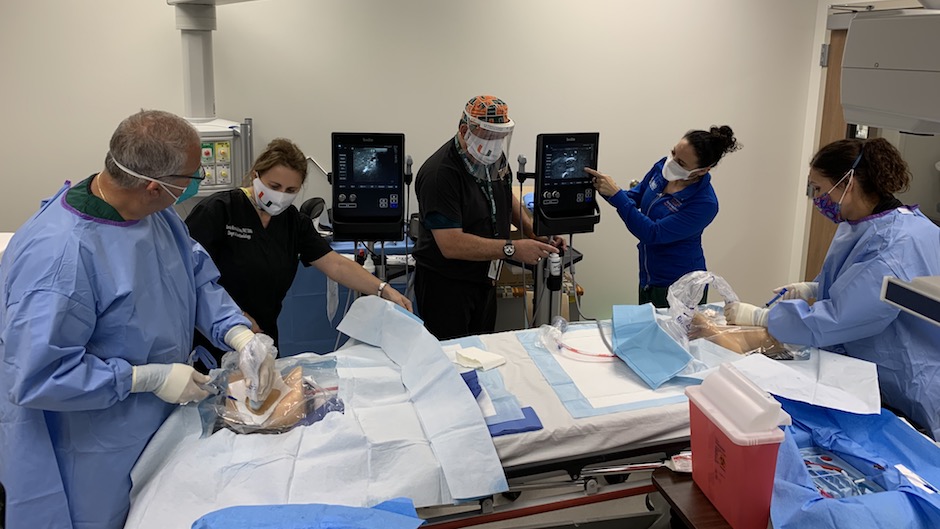Patients in intensive care units, including those with COVID-19, often require multiple venipunctures for labs and medication administration. To reduce frequency of these punctures, sometimes a central venous catheter—a large intravenous line in the neck—is used.
Given the delicacy of inserting a catheter into an internal jugular vein, central line placement is a highly specialized skill that practitioners often need to refresh. On July 27, a team of certified registered nurse anesthetists (CRNAs) from UHealth Tower had the chance to do just that at the Simulation Hospital for Advancing Research and Education (S.H.A.R.E.™).
Leading the CRNAs in their refresher sessions were Juan E. Gonzalez, PhD, CRNA, and Greta Mitzova-Vladinov, DNP, APRN, CRNA, CHSE, director and associate director, respectively, of the BSN-DNP Nurse Anesthesia Program at the University of Miami School of Nursing and Health Studies (SONHS). Assisting was adjunct faculty member Maritz Forero, CRNA, MSN, UHealth Tower’s chief CRNA.
Mitzova-Vladinov, associate professor of clinical, came up with the idea of offering her UM colleagues the ability to practice skills in a simulated setting using ultrasound-guided techniques, which are more prevalent nowadays. “This gives us a chance to serve our nurse anesthetists in the UM community, so they can better serve our community at large during the COVID-19 pandemic,” she says.
Among the CRNAs who took part in the simulation session at S.H.A.R.E.™ were Gilberto Soto and Deanna Dupont, members of UHealth Tower’s nurse anesthesia team. Usually they work in the operating room, but with the advent of the COVID-19 crisis, and resulting restriction in the number of OR cases, they are now serving in the intensive care unit.
“Training with our state-of-the-art ultrasound machines and task-trainer props will allow these health care professionals who are providing care in the ICUs at UHealth Tower, including in COVID units, to continue providing excellent care to their patients using best-evidence practices in the clinical arena,” says Gonzalez, professor of clinical.
On-site assistance at S.H.A.R.E.™ was provided by Donna McDermott, PhD, RN, associate dean for Simulation Programs; Jeffrey Groom, PhD, CRNA, director of special projects; and simulation technicians Luis Perez and Robert Brau.
